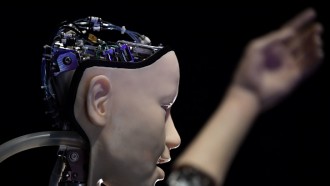
MIT engineers created a device to monitor vitals and have the same elasticity and feel of human skin, and it's sweat-proof too!
What Makes This E-Skin Different?
There are already existing e-skins that exist. However, they all have major design flaws that do not make them work under certain conditions.
The previous e-skins have trouble sticking, especially when it's exposed to sweat. That's whenMIT researchersdeveloped their type of e-skin that can still work despite sweat.
Jeehwan Kim, a mechanical engineer at MIT, said that the skin is comfortable, breathable, and won't get data wrong even if the person is sweating. He also said, "We can provide wearable sensors that can do constant long-term monitoring."
Optimist Dailyreported that the device integrates artificial sweat ducts that mimic the pores in human skin. The materials used are ultrathin layers that are designed to ensure that the sweat accumulated can easily escape through the e-skin, avoiding deteriorating effects and peeling away.
Read More:Biden: US Vaccination to Go 'Knock on Doors,' Get More Americans to Receive the COVID-19 Shots
Ingenious Inspiration
TheMITresearchers thoroughly studied the physiology of actual human skin as their inspiration. They determined that the sweat pores are the key, and how they should go around making the health-monitoring e-skin.
Tests were then done, and the e-skin was stuck to a volunteer's forehead and wrist for a week. T
he sensors were able to detect his temperature, UV exposure, hydration levels, and pulse. Despite the volunteer doing sweat-inducing activities, like doing cardio exercises for 30 minutes and consuming spicy food, the device was still able to maintain its integrity and regularly transmit data of the volunteer's vitals.
The next step for the MIT engineers is to enhance the e-skins' durability and strength to further improve the monitoring device.
Hanwool Yeon, lead author, and MIT grad said, "Because the e-skin is very soft, it can be physically damaged ... We aim to improve the resilience of electronic skin."
The e-skin designed by MIT engineers is a potential step towards detecting skin cancer and other illnesses on top of its already impressive health-monitoring function, as told byScience Advances.
How Was The E-Skin Created?
Kim's team is experts in creating flexible semiconductor films as well as pioneering a technique named remote epitaxy.
远程外延是一个过程,涉及越来越多ultrathin yet high-quality semiconductor films at high temperatures. Once selectively peeling away the films, they can combine and stack each of them to form a myriad of sensors that are far thinner as compared to other wafer-based designs in the past.
They then used human skin as inspiration for how to overcome the previous e-skin designs that always fail in their purpose of gathering data.
Amorepacific is a company that followed Kim and his team's work and was able to collaborate with the latter. The goal was to create an e-skin that could be worn for extended periods.The collaboration bore fruit and that is the very first e-skin that is sweat-proof and can be the future of tracking vitals without the worry of invasive techniques or fear of sensors peeling away.
Read More:Lambda Strain COVID-19 Update, Experts Have Mixed Opinions About Delta vs. Lamda Being Worse
This article is owned by Tech Times
Written by Alec G.












![[eFlair1] Top 10 React.js Development Agencies You Should Consider in 2023](https://1734811051.rsc.cdn77.org/data/thumbs/full/426743/295/166/50/40/eflair1-top-10-react-js-development-agencies-you-should-consider-in-2023.jpg)
